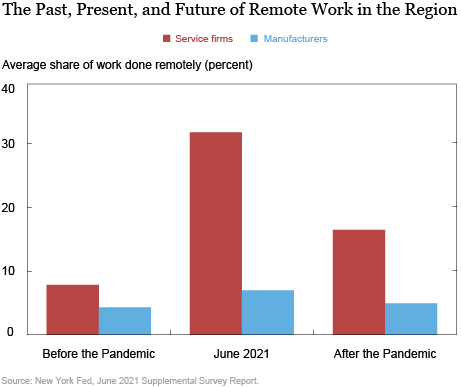The coronavirus pandemic abruptly changed the way we work, in meaningful and potentially lasting ways. While working from home represented a small share of work before the pandemic, such arrangements became unexpectedly widespread once the pandemic struck. With the pandemic now being brought under control and conditions improving, workers have begun to return to the office. But just how much remote work will persist in the new normal? The New York Fed’s June regional business surveys asked firms about the extent of remote working before, during, and after the pandemic. Results indicate that before the pandemic, the average firm in the region conducted just a small share of its work remotely, a figure that currently stands at around a third among service firms but well below 10 percent among manufacturers. Once the pandemic is fully behind us, service firms expect double the amount of remote work than before the pandemic, though that figure is less than the share being done currently, while manufacturers expect the amount of remote work to return to where it was before the pandemic.
Remote Work Before the Pandemic
Working from home was not particularly widespread in the region before the pandemic, though it was not unusual for firms to have at least some remote workers. Supplementary questions to this month’s Empire State Manufacturing Survey and Business Leaders Survey asked firms in the region to estimate the share of their workers who were doing at least some work remotely and how many days of the week these remote workers were typically offsite—before the pandemic, currently, and what they expect after the pandemic. Responses indicate that roughly half of service firms and just over one-third of manufacturers had at least some remote workers pre-pandemic. As the chart below shows, we estimate that an average of around 8 percent of all service work and 4 percent of all manufacturing work was done remotely before the pandemic. These estimates are in line with figures from a nationally representative survey conducted before the pandemic that found that roughly 5 percent of pre‑pandemic work was done from home.

To calculate the share of work being done remotely for each firm, we multiply the share of workers working remotely by the average percentage of time these workers telecommuted. Our surveys indicate that an average of about 10 percent of workers across the region’s service sector worked remotely before the pandemic, and those workers telecommuted for an average of four days out of a five-day workweek, such that 10% x 80% = 8%. Among manufacturers, an average of just under 5 percent of a firm’s workers were remote, for an average of four and a half days out of the workweek (4.9% x 90% = 4%).
The Rise of Remote Work
Remote work increased sharply in the region during the pandemic and remains elevated. Indeed, several studies (in May 2020, June 2020, and April 2021) find that more than half of all work was done from home early in the pandemic. Responses to our surveys indicate that, on average, about 40 percent of the average firm’s employees are currently working remotely for just over four days per week, suggesting that about a third of all paid work in the region’s service sector is now being done remotely.
Of course, there is wide variation in the amount of remote work being done within the service sector due to differences in the nature of work: it is widespread in the business services, finance, and information sectors, but not particularly common in the construction or leisure and hospitality sectors. The amount of remote work also increased in the region’s manufacturing sector, though not to the same extent as in the service sector. Survey results suggest that nearly 10 percent of manufacturing workers currently work from home for just shy of four days per week, indicating the average share of remote manufacturing work is at about 7 percent.
The Future of Remote Work
What will the landscape of remote work look like in the region once the pandemic is behind us? Undoubtedly, remote work will be more common than it once was, but not as prevalent as it was during the pandemic. Once conditions reach a new normal, service firms in the region expect about a quarter of their workforce to work remotely for, on average, about three and a half days per week, such that the average service firm expects about 16 percent of its work to be performed remotely—about double its pre‑pandemic share. Regional manufacturers expect about 6 percent of their workforce to work remotely for, on average, about four days per week, such that the average manufacturing firm expects 5 percent of work to be performed remotely—just slightly more than before the pandemic. While our data do not allow a full analysis of New York City, we find some evidence that remote working is expected to be more prevalent there than in the rest of the region, especially in Manhattan, where office work is much more common.
Our estimates of the expected share of remote work are somewhat lower than a recent national survey of worker expectations, which found that about 20 percent of work is expected to be done remotely, but are in line with recent estimates from another national survey of firms. Some of this difference may be because workers and firms have different expectations about the future of remote working. Indeed, recent research indicates workers generally would like to work from home more than employers plan to allow after the pandemic.
Interestingly, much remote work was “all or nothing” before and during the pandemic, where workers were remote for the entire workweek or not at all. Our survey suggests that it will be much more common for workers to work from home part of the week and work onsite part of the week after the pandemic than before. Thus, the future of work will likely settle into a blend of both worlds.
 Jaison R. Abel is an assistant vice president in the Federal Reserve Bank of New York’s Research and Statistics Group.
Jaison R. Abel is an assistant vice president in the Federal Reserve Bank of New York’s Research and Statistics Group. Jason Bram is a research officer in the Bank’s Research and Statistics Group.
Jason Bram is a research officer in the Bank’s Research and Statistics Group. Richard Deitz is an assistant vice president in the Bank’s Research and Statistics Group.
Richard Deitz is an assistant vice president in the Bank’s Research and Statistics Group.
Jessica Lu is a senior research analyst in the Bank’s Research and Statistics Group.
How to cite this post:
Jaison R. Abel, Jason Bram, Richard Deitz, and Jessica Lu, “The Future of Remote Work in the Region,” Federal Reserve Bank of New York Liberty Street Economics, June 18, 2021, https://libertystreeteconomics.newyorkfed.org/2021/06/the-future-of-remote-work-in-the-region.html.
Related Reading
Empire State Manufacturing Survey
Business Leaders Survey
Supplemental Survey Report
Disclaimer
The views expressed in this post are those of the authors and do not necessarily reflect the position of the Federal Reserve Bank of New York or the Federal Reserve System. Any errors or omissions are the responsibility of the authors.











 RSS Feed
RSS Feed Follow Liberty Street Economics
Follow Liberty Street Economics